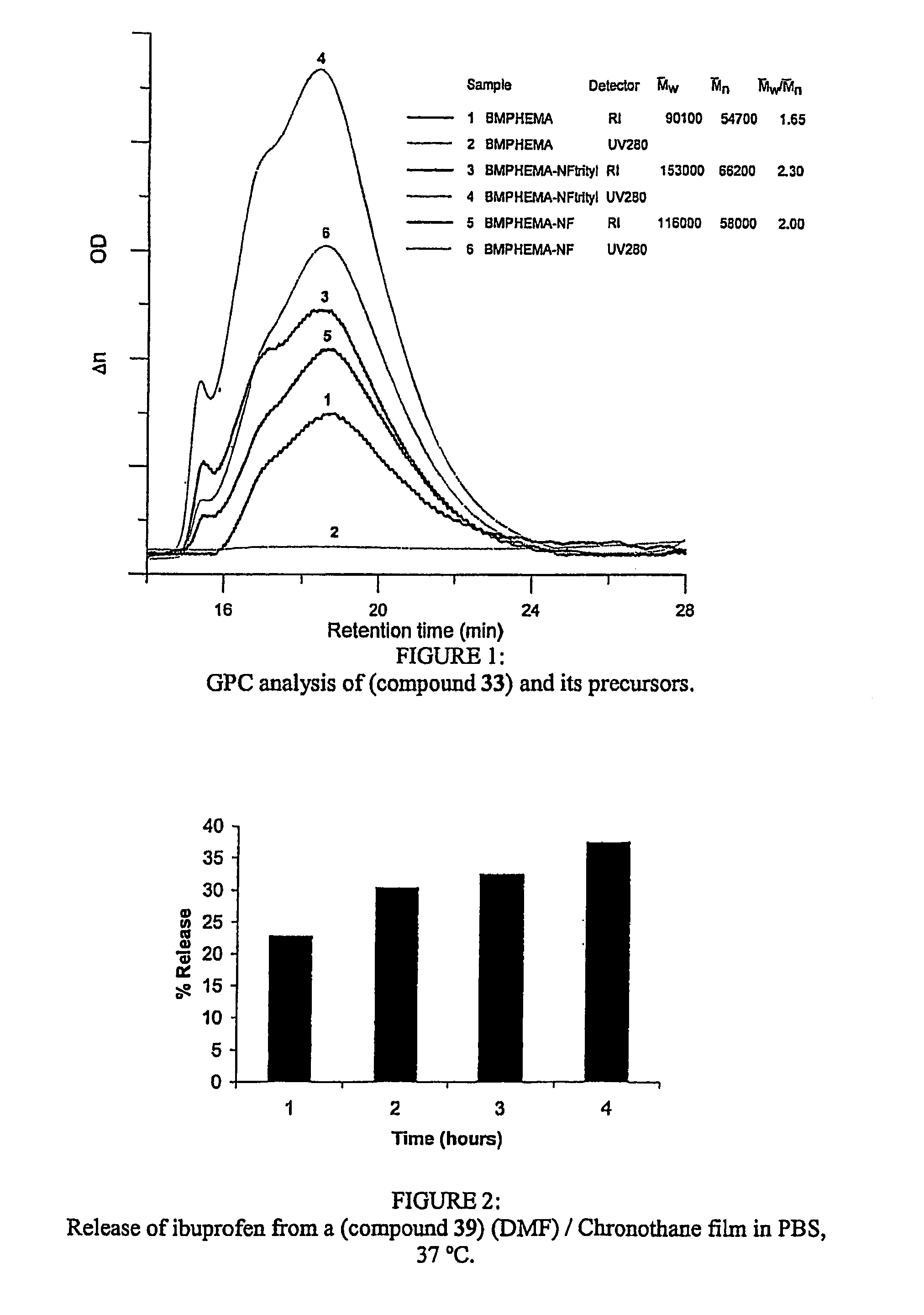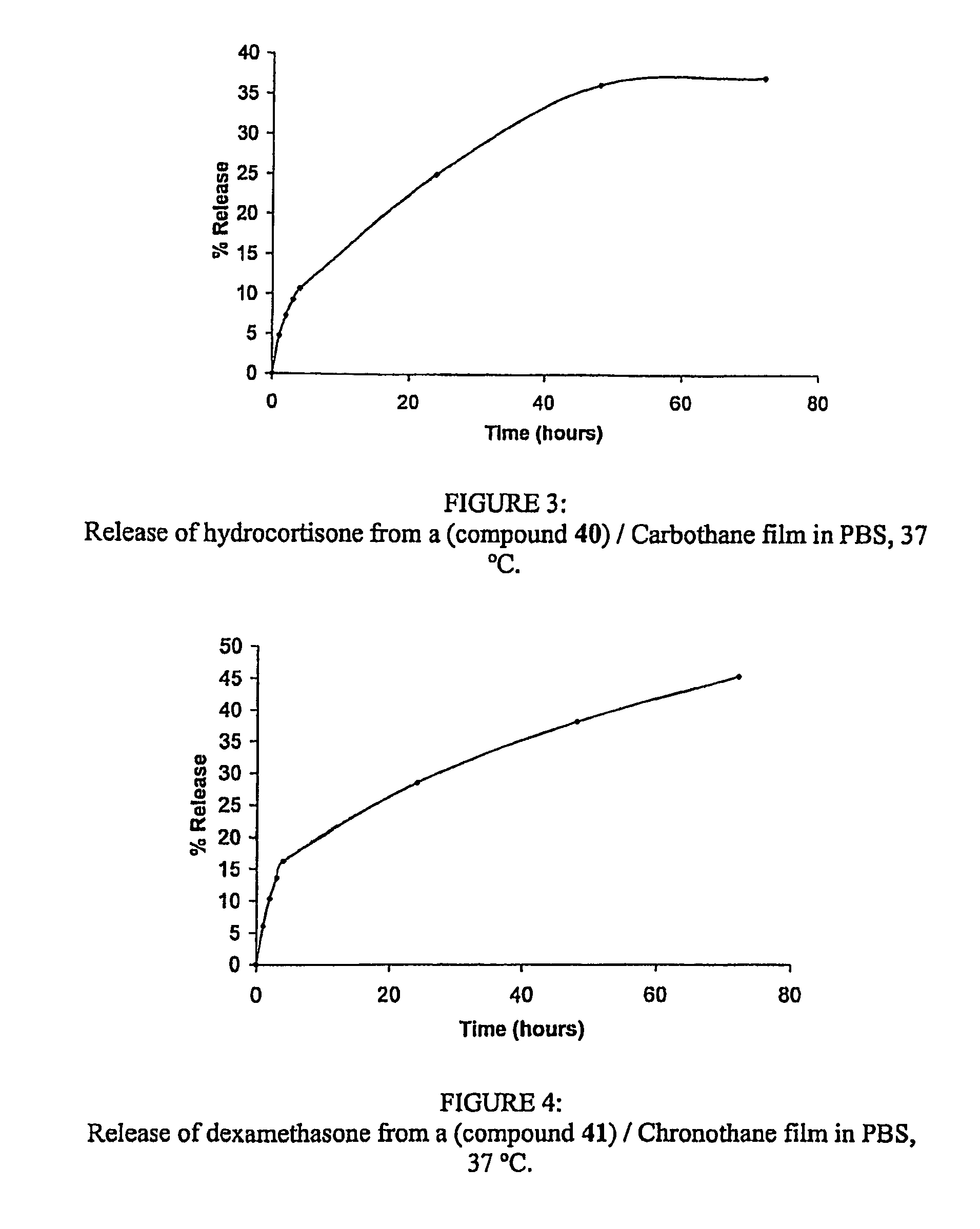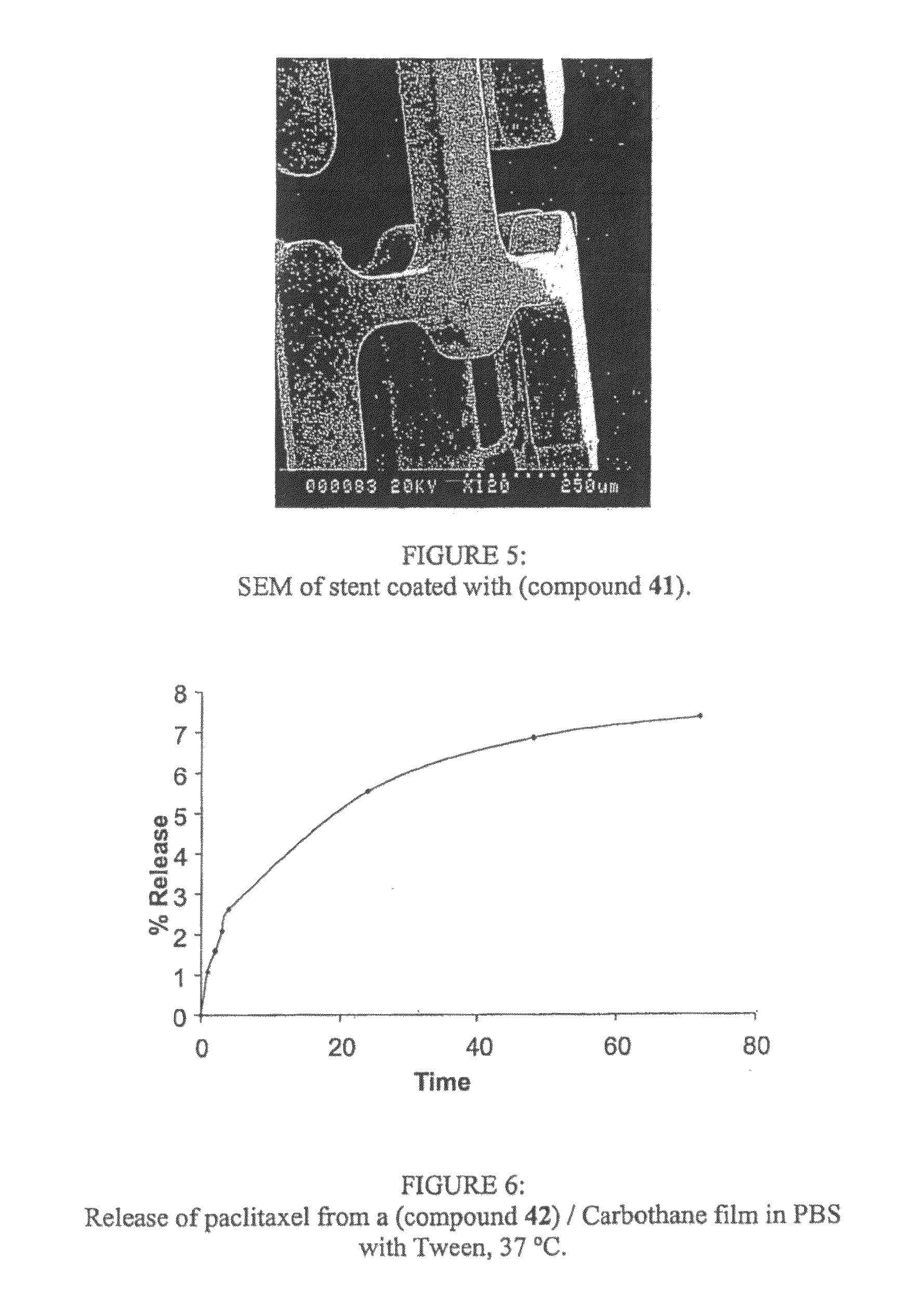Grafted polymers and uses thereof
a technology of grafted polymers and polymers, which is applied in the direction of powder delivery, immobilised enzymes, water/sewage treatment by ion exchange, etc., can solve the problems of difficult to precisely reproduce the structure of products, difficulty in ensuring the quality of products, and side effects, so as to reduce thrombosis, control the migration and release of active agents, and the effect of reducing thrombosis
- Summary
- Abstract
- Description
- Claims
- Application Information
AI Technical Summary
Benefits of technology
Problems solved by technology
Method used
Image
Examples
example 24
α,ω-BAL-poly(LDI / PTMO)-p-PMAA (Compound 26): Ibuprofen (Compound 39)
[0285]Ibuprofen: this compound is a non-steroidal anti-inflammatory drug. Its mechanism of action is through inhibition of cyclooxygenase (COX) and hence prostaglandin synthesis.
[0286]Ibuprofen (0.469 g, 2.3×10−3 mol) was dissolved in DMF (2 mL). (Compound 26) (0.054 g, 8.68 mg ibuprofen / mg of (compound 26)) was dissolved in DMF (2 mL) at room temperature under a nitrogen atmosphere. Once completely dissolved, the ibuprofen solution was added dropwise, over 75 minutes, to the (compound 26) solution. The reaction mixture was sealed and left under a nitrogen atmosphere for 24 hours. The excess solvent was removed and the final product (compound 39) was isolated and dried. Film preparation: the isolated product (35 mg) was dissolved in a 10% DMF solution of Chronothane 80A (6 mL). This solution was pipetted into 4×4 cm PTFE wells and cast into films. Films were processed in a 60° C. flow oven and a 50° C. vacuum oven. ...
example 25
α,ω-BAL-poly(LDI / PTMO)-p-PMAA (Compound 26): Hydrocortisone (Compound 40)
[0288]Hydrocortisone: this compound is known as a corticosteroid hormone which is produced by the adrenal cortex. It is generally used for the treatment of allergies and inflammation.
[0289]Hydrocortisone (0.764 g, 2.1×10−3 mol) was dissolved in methanol (80 mL). (Compound 26) (0.050 g, 15.3 mg hydrocortisone / mg of (compound 26)) was dissolved in methanol (20 mL) at room temperature under a nitrogen atmosphere. Once completely dissolved, the hydrocortisone solution was added dropwise, over 100 minutes, to the (compound 26) solution. The reaction mixture was sealed and left under a nitrogen atmosphere for 72 hours. The excess solvent was removed and the final product (compound 40) was isolated and dried. Film preparation: (compound 26) (33 mg) was dissolved in a 10% DMAc solution of Carbothane 85A (6 mL). This solution was pipetted into a 4×4 cm PTFE well and cast into a film. The film was processed in a 60° C. f...
example 26
α,ω-BAL-poly(LDI / PTMO)-p-PMAA (Compound 26): Dexamethasone (Compound 41)
[0290]Dexamethasone: dexamethasone is a potent synthetic member of the glucocortid class of steroid hormones. It acts as an anti-inflammatory and immunosuppressant. Its potency is about 40 times that of hydrocortisone.
[0291]Dexamethasone (0.332 g, 8.46×10−4 mol) was dissolved in methanol (11 mL). (Compound 26) (0.100 g, 3.32 mg dexamethasone / mg of (compound 26)) was dissolved in methanol (3 mL) at room temperature under a nitrogen atmosphere. Once completely dissolved, the dexamethasone solution was added dropwise, over 120 minutes, to the (compound 26) solution. The reaction mixture was sealed and left under a nitrogen atmosphere for 72 hours. The excess solvent was removed and the final product (compound 41) was isolated and dried. Film preparation: the isolated product (29 mg) was dissolved in a 10% DMF solution of Chronothane 80A (6 mL). This solution was pipetted into a 4×4 cm PTFE well and cast into a film...
PUM
| Property | Measurement | Unit |
|---|---|---|
| molecular weight | aaaaa | aaaaa |
| absolute molecular weight | aaaaa | aaaaa |
| molecular weight | aaaaa | aaaaa |
Abstract
Description
Claims
Application Information
 Login to View More
Login to View More - R&D
- Intellectual Property
- Life Sciences
- Materials
- Tech Scout
- Unparalleled Data Quality
- Higher Quality Content
- 60% Fewer Hallucinations
Browse by: Latest US Patents, China's latest patents, Technical Efficacy Thesaurus, Application Domain, Technology Topic, Popular Technical Reports.
© 2025 PatSnap. All rights reserved.Legal|Privacy policy|Modern Slavery Act Transparency Statement|Sitemap|About US| Contact US: help@patsnap.com



